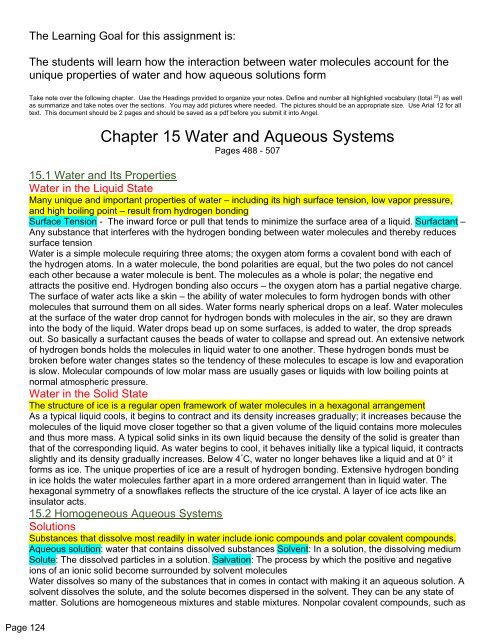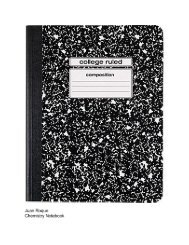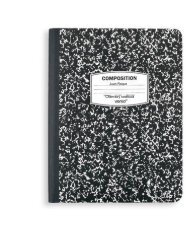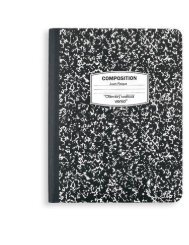Create successful ePaper yourself
Turn your PDF publications into a flip-book with our unique Google optimized e-Paper software.
The Learning Goal for this assignment is:<br />
The students will learn how the interaction between water molecules account for the<br />
unique properties of water and how aqueous solutions form<br />
Page 124<br />
Take note over the following chapter. Use the Headings provided to organize your notes. Define and number all highlighted vocabulary (total 22 ) as well<br />
as summarize and take notes over the sections. You may add pictures where needed. The pictures should be an appropriate size. Use Arial 12 for all<br />
text. This document should be 2 pages and should be saved as a pdf before you submit it into Angel.<br />
Chapter 15 Water and Aqueous Systems<br />
Pages 488 - 507<br />
15.1 Water and Its Properties<br />
Water in the Liquid State<br />
Many unique and important properties of water – including its high surface tension, low vapor pressure,<br />
and high boiling point – result from hydrogen bonding<br />
Surface Tension - The inward force or pull that tends to minimize the surface area of a liquid. Surfactant –<br />
Any substance that interferes with the hydrogen bonding between water molecules and thereby reduces<br />
surface tension<br />
Water is a simple molecule requiring three atoms; the oxygen atom forms a covalent bond with each of<br />
the hydrogen atoms. In a water molecule, the bond polarities are equal, but the two poles do not cancel<br />
each other because a water molecule is bent. The molecules as a whole is polar; the negative end<br />
attracts the positive end. Hydrogen bonding also occurs – the oxygen atom has a partial negative charge.<br />
The surface of water acts like a skin – the ability of water molecules to form hydrogen bonds with other<br />
molecules that surround them on all sides. Water forms nearly spherical drops on a leaf. Water molecules<br />
at the surface of the water drop cannot for hydrogen bonds with molecules in the air, so they are drawn<br />
into the body of the liquid. Water drops bead up on some surfaces, is added to water, the drop spreads<br />
out. So basically a surfactant causes the beads of water to collapse and spread out. An extensive network<br />
of hydrogen bonds holds the molecules in liquid water to one another. These hydrogen bonds must be<br />
broken before water changes states so the tendency of these molecules to escape is low and evaporation<br />
is slow. Molecular compounds of low molar mass are usually gases or liquids with low boiling points at<br />
normal atmospheric pressure.<br />
Water in the Solid State<br />
The structure of ice is a regular open framework of water molecules in a hexagonal arrangement<br />
As a typical liquid cools, it begins to contract and its density increases gradually; it increases because the<br />
molecules of the liquid move closer together so that a given volume of the liquid contains more molecules<br />
and thus more mass. A typical solid sinks in its own liquid because the density of the solid is greater than<br />
that of the corresponding liquid. As water begins to cool, it behaves initially like a typical liquid, it contracts<br />
slightly and its density gradually increases. Below 4 ° C, water no longer behaves like a liquid and at 0° it<br />
forms as ice. The unique properties of ice are a result of hydrogen bonding. Extensive hydrogen bonding<br />
in ice holds the water molecules farther apart in a more ordered arrangement than in liquid water. The<br />
hexagonal symmetry of a snowflakes reflects the structure of the ice crystal. A layer of ice acts like an<br />
insulator acts.<br />
15.2 Homogeneous Aqueous Systems<br />
Solutions<br />
Substances that dissolve most readily in water include ionic compounds and polar covalent compounds.<br />
Aqueous solution: water that contains dissolved substances Solvent: In a solution, the dissolving medium<br />
Solute: The dissolved particles in a solution. Salvation: The process by which the positive and negative<br />
ions of an ionic solid become surrounded by solvent molecules<br />
Water dissolves so many of the substances that in comes in contact with making it an aqueous solution. A<br />
solvent dissolves the solute, and the solute becomes dispersed in the solvent. They can be any state of<br />
matter. Solutions are homogeneous mixtures and stable mixtures. Nonpolar covalent compounds, such as






